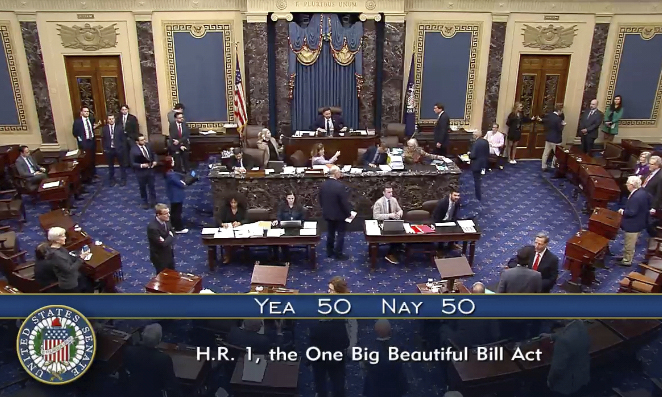WASHINGTON (NEXSTAR) – In a dramatic turn of events, the Senate has passed a controversial bill championed by President Donald Trump, following a rare tie-breaking vote cast by Vice President JD Vance. The decision came after an exhaustive 27-hour voting marathon, ultimately securing enough Republican support to move the bill forward.
The bill, often referred to by President Trump as his “big, beautiful bill,” now returns to the House of Representatives. It originally passed there by a narrow margin, but some of the amendments introduced by the Senate have stirred discontent among House members.
Key Provisions and Controversies
The legislation includes several significant measures: a permanent extension of the 2017 tax cuts, the elimination of taxes on tips, and a substantial $350 billion allocation for border security. Despite these provisions, the bill faced considerable opposition within the Senate.
Three Republican senators, including Rand Paul, Susan Collins, and Thom Tillis, voted against the bill. Senator Paul criticized the bill for its potential fiscal impact, stating, “The bill, which was supposed to cut spending, will add $270 billion to the national debt next year.”
Senators Collins and Tillis expressed concerns over the bill’s cuts to Medicaid, aligning with every Democrat in opposing the legislation. According to the Congressional Budget Office, the bill could result in a $1.5 trillion reduction in federal spending over the next decade, but also lead to approximately 12 million Americans losing Medicaid coverage.
Senate’s Grueling Debate and Vote
The passage of the bill followed an intense period of debate and voting on various amendments. Senators worked tirelessly throughout Monday and into Tuesday, reflecting the contentious nature of the legislation. The amendments and discussions highlighted deep partisan divides, particularly regarding fiscal responsibility and social safety nets.
The Congressional Budget Office estimates the bill will cut $1.5 trillion in federal spending over ten years, impacting Medicaid coverage for 12 million Americans.
Implications and Next Steps
With the Senate’s approval, the bill now faces another round of voting in the House of Representatives. The House must consider the Senate’s changes, some of which have already been met with resistance. The outcome of this vote will determine the bill’s final form and its potential enactment into law.
The bill’s journey through Congress underscores the ongoing debates over fiscal policy, tax reform, and healthcare in the United States. As lawmakers prepare for the next vote, the implications for the national debt, healthcare access, and economic policy remain at the forefront of political discourse.
As the legislative process continues, stakeholders and citizens alike will be closely monitoring the developments, aware of the profound impact the bill could have on various facets of American life.
